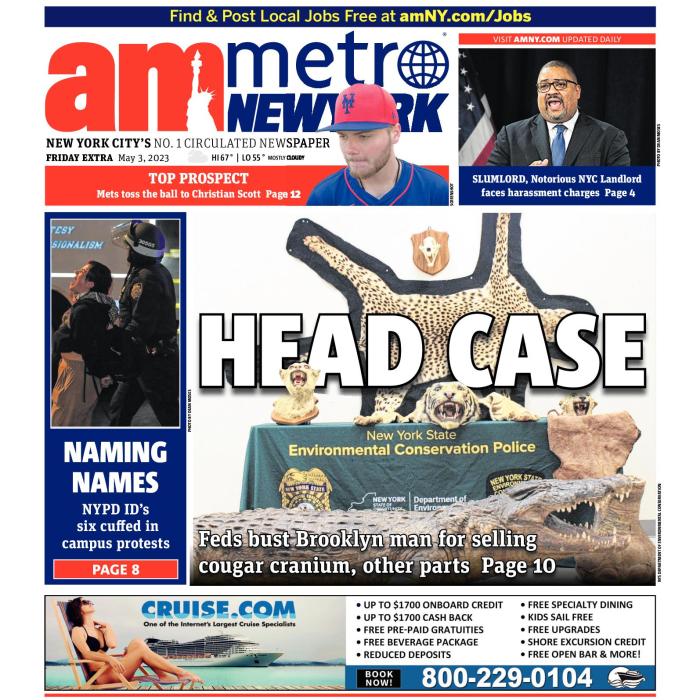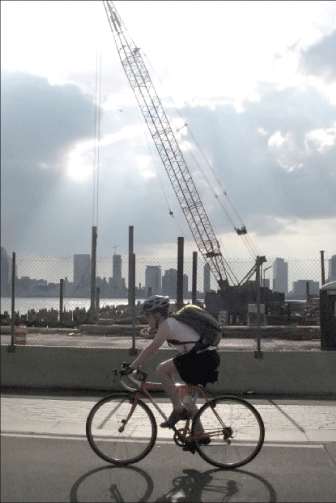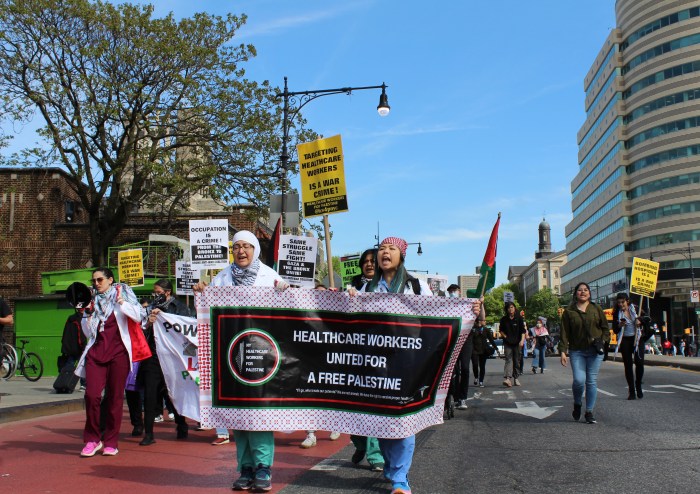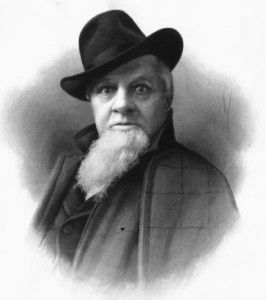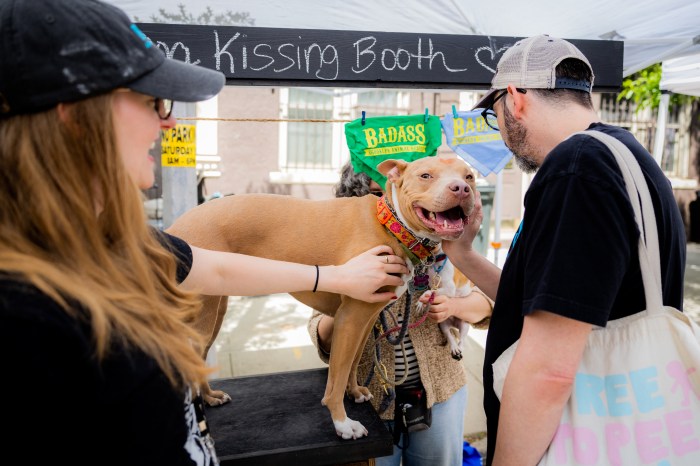By Josh Rogers
Connie Fishman, Hudson River Park Trust president, said park visitors who miss the Tribeca piers that closed two years ago will get them back in 2010, despite the current budget shortfall.
“I don’t think they should be concerned,” Fishman told Downtown Express. “I think we’ll get funded for the park in Tribeca just as we were funded in Greenwich Village, and we are being funded in Chelsea, and we were funded in Clinton.”
Editors and reporters from Community Media L.L.C., publishers of the Express, The Villager and Chelsea Now, interviewed Fishman and her executive vice president, Noreen Doyle, Thursday in the papers’ office.
The Trust’s leaders revealed new details on the park’s financing in a wide-ranging, hour-long interview regarding the 5-mile riverside park.
Fishman said the park is like a business and in order to keep it running, Pier 40 must generate more money. The Trust is considering two plans to redevelop the pier, one of which will add a cinema, two 1,800-person performance spaces, restaurants and retail to the 14-acre pier between Clarkson and Spring Sts. The pier’s parking only brings in $5 million a year and it won’t cover repairs to the pier and enough of the park’s maintenance costs, Fishman said. The Trust, a state-city public authority, is responsible for the park’s upkeep.
“As much as it acts like a government agency it has to run like a business,” Fishman said.
Her future with the Trust is also unclear. Many waterfront advocates have been privately lobbying for her to stay, but in recent months some others upset with her management in Tribeca have said she should go.
The governor and mayor share control of the Trust and Fishman first came to the agency from the Giuliani administration at the end of the ‘90s. She was promoted to president just over three years ago with then-Governor George Pataki’s blessing. Trip Dorkey, the Trust’s chairperson and a Pataki appointee, announced he would be leaving two weeks ago, and new Gov. Eliot Spitzer is expected to name Dorkey’s successor before the Trust’s next board meeting in July.
Fishman said her future is up to the governor and mayor and last week she passed on a chance to make her case for staying. “If they decide to ask me that question, I’m sure I’ll have an answer to it,” she said.
Tribeca shortfall
Community Board 1 members were surprised to learn recently that the $75 million of federal money committed to the park’s Tribeca section would not cover any of the park elements because of rising construction costs. The completion date has been pushed back.
Pier 25, with its beach volleyball, children’s play area, mini-golf, picnic tables, historic ships and marina, could draw thousands of visitors on a summer weekend day.
“We’re building Pier 25,” Fishman said. “We can’t put the cool stuff on top of it anyway — until a year from this fall when the pier is complete.”
Originally the Trust hoped a $70 million grant from the Lower Manhattan Development Corp. and a $5 million Congressional earmark from U.S. Rep. Jerrold Nadler would cover almost all of the Tribeca section. But now, the Trust needs about $28 million more to rebuild most of it and Fishman hopes to get the state Legislature and City Council to pay for it in future budget years.
Fishman said the pile work at Piers 25 and 26 should finish by November and if there is a mild winter, most of the deck should be done by next spring, at which point the trust would need more money to continue the work on pier structures.
Piers 25 and 26 were deteriorating and the plan is to rebuild them to 1,000 and 600 feet, larger than they were before they closed. A small turf field is planned for Pier 25, and 26 will have a restaurant added to the boathouse and river study center, or estuarium.
Fishman said the Tribeca completion date delay was caused by a federal delay getting final approval for the L.M.D.C. money, but that contradicted repeated statements Trust officials made last summer and fall after the $70 million was approved in 2006.
When the piers closed at the end of 2005, the completion goal was 2008, when work finally began in the summer it was 2009 and it was only this year when the Trust acknowledged further delays.
Bob Townley, executive director of Manhattan Youth, which leased Pier 25 from the Trust, said every lost year hurts. He monitors the Tribeca work almost obsessively from his Battery Park City apartment.
“I look out my window and my son comes home early and I ask him ‘did they bang the piles?’ I just want them to keep banging,” he said. Pier 25 “is a place for kids to play and relax. That pier was packed on the weekend – 2010 would be bad,” said Townley, an eternal optimist who has not given up on 2008.
Fishman said she understands the pier’s importance — “my kids have been going to Pier 25 since they were in kindergarten,” and Doyle said it will be better than it ever was. “I think Pier 25 is going to be the most fun pier in the entire park. I can’t wait to go there,” said the Trust’s vice president.
Townley said parents ask him about the piers all of the time. “They’re concerned,” he said. “They say, ‘Bob, what’s going on? Is this another government boondoggle?’” I tell them no.”
The Trust’s working number for the budget shortfall for completing the park’s construction is $120 million, but the true gap is much higher. In Tribeca, the money to build the estuarium and an “eco-pier” bird sanctuary near Canal St. is not counted because the Trust is hoping for environmental grants to pay for them, and about $8 million of the cost overruns have not yet been included because it is a preliminary estimate.
Elsewhere in the park, there is no cost estimate or park design for the Village’s Gansevoort Peninsula, currently being used by the Sanitation Dept., or for the 50 percent of the Tow Pound slated to be added to the park.
Pier 40
About 1,500 people jammed into a meeting at P.S. 41 last month to raise their objections to two plans to redevelop Pier 40. Many opposed the idea of closing the pier’s playing fields during construction of an entertainment complex, but others criticized the notion of converting a playing-parking place into what they call a “Vegas on the Hudson” nightlife destination. Only half that message reached the Trust.
“The only thing I think we’ve heard loud and clear from the community is ballfields, ballfields — don’t take away our ballfields,” Fishman said.
Doyle said the Trust is not satisfied with either developer’s traffic plan. “Traffic is going to be one of the biggest issues for anything that goes on at Pier 40,” she added.
The People’s Pier proposal by Urban Dove and CampGroup would add indoor recreation and day camp space to the parking and fields and would draw fewer cars than Related’s plan for an entertainment shopping complex and parking. Related’s Anthony Fioravanti acknowledged the traffic plan submitted in response to the request for proposals (R.F.P.) needed more changes.
“Right now you’ve got walking traffic and vehicle traffic coming into the same spot,” he said in an interview with Community Media. “I don’t presume we got everything right in the couple of weeks literally, or months that we put together an R.F.P. It’s a process — we’re moving toward getting it well.”
The Trust said last week that in order to continue to collect the $5 million in parking revenues, they will need $15 million for roof repairs (the developers would need more for the roof for their plans) $5 million – $10 million for underwater reinforcements, and an undetermined amount for façade repairs that the Trust leaders are certain is less than the roof costs. They said the repairs will all have to be done within the next five years and is one of the reasons the pier needs to be redeveloped.
Currently Pier 40 contributes 40 percent of the park’s maintenance costs, with almost all of the rest coming from Chelsea Piers and World Yacht cruises in Midtown. Fishman said the intent is to keep the percentages roughly the same, but when asked if that amounted to a limit on Pier 40 revenues, she said the Trust runs like a business and must make sure it has money to pay for maintenance in the future.
If the park were fully built now, it would cost $15 million – $20 million a year to maintain, Fishman said, meaning under the formula, the Trust would want up to $8 million from Pier 40.
The Trust released the Pier 40 R.F.P. last summer and Fishman disputed the contention that local politicians and community leaders had objections.
“The elected officials were completely on board with the R.F.P. itself in terms of — they reviewed it they made suggestions, they looked at everything before it went out, ” she said.
Assemblymember Deborah Glick last week said “we objected that in the waning days of the Pataki administration that they were even issuing an R.F.P. We objected to the speed of the R.P.P.”
Last year even one of Glick’s chief political foes, Arthur Schwartz, who at the time was chairperson of Community Board 2’s Waterfront Committee, and others in the Village agreed with Glick that the proposal request was rushed. Schwartz said then that “I asked Connie Fishman if we could have a public meeting on [the R.F.P.] and she said, ‘No, I want to get it out.’”
Investigations and Pier 57
This is the second time the Trust has looked for a Pier 40 developer and Doyle said “we could point to an incredibly successful Pier 57 process” to assuage wary developers at Pier 40. She said there was overwhelming community support for the plan to add Italian culture, crafts and retail to Pier 57 near 16th St. in 2005, when the plan was selected.
Yet now it remains stalled. One member of the development team, Giuseppe Cipriani, pulled out last year.
Fishman confirmed there was an investigation into the Pier 57 selection process and said it was a possible reason why the city has not yet approved the deal. The other possibility, she said, is it would be the Trust’s first long-term lease and there are added administrative hurdles to clear. Both could be true, she said. Fishman said prosecutors typically don’t disclose the target of investigations and she did not know who was or is the subject of the probe.
Last year, a few C.B. 2 members said the city Dept. of Investigation asked them questions regarding Pier 40. Fishman said she did not know about a Pier 40 inquiry. “If there was [an investigation], it wasn’t something anybody had to speak to us about,” she said.
But the main thing on her mind these days appears to be money for the park, or as she said “nobody is going to make [it] out of Play-Doh.”
Josh@DowntownExpress.com
